It was 30 years before the time felt right for these filmmakers to explore the Vietnam War, and it took another decade to do it properly.
For Americans who grew up learning social studies, watching Jeopardy! and playing Trivial Pursuit, history is supposed to be about answering questions. For documentary filmmakers Ken Burns and Lynn Novick, however, the point of history has always been to ask them.
That’s especially true with respect to their latest film series, The Vietnam War, premiering Sept. 17 on PBS. Barely a minute into the first episode, Vietnam War veteran Karl Marlantes articulates the burning question to which Burns and Novick have devoted 10 episodes and 18 hours.
“For years, nobody talked about Vietnam, ” says Marlantes, a former Marine Corps officer. “It was so divisive. It’s like living in a family with an alcoholic father: ‘Shhh! We don’ t talk about that.’ Our country did that with Vietnam, and it’s only been very recently that the baby boomers are finally starting to say, ‘What happened? What happened?’ ”
Because there has never been a consensus answer to that question, Burns and Novick spent the past decade asking it of witnesses and historians. The resulting piece of cinematic scholarship is not only a monument to art and history, but also a testament to the hard work that is filmmaking.
Of course, Burns has made war documentaries before: 1990’s The Civil War and 2007’s The War, about World War II on the home front. This time, however, there’s a personal connection, as Burns experienced the Vietnam era as an adolescent in Ann Arbor, Mich., where his father taught at the University of Michigan.
“I didn’ t go to the University of Michigan, but the campus there was a hotbed for antiwar demonstrations and unrest, ” says Burns, who co-directed The Vietnam War with Novick and co-produced it with her and longtime collaborator Sarah Botstein. “One of the war’s first teach-ins occurred in the anthropology department there in 1965. My father worked in that department… so I was very much aware of the war and followed it closely.”
Although Burns was not drafted — he turned 18 in 1971 — the war still left a deep and lasting impression. So much so that he has long wanted to make a film about Vietnam. Because the wounds were so fresh, however, the timing never seemed right.
“We’ ve been talking about doing something with Vietnam for as long as I’ ve known Ken, ” Novick says. “The Vietnam War was the most important event in American history since World War II. So being as interested as we are in American history, we felt we had to go there at some point. But when Ken and I started working together in the late’ 80s, the war was still relatively recent. We wanted to wait for more time to pass.”
In 2006, as they were finishing The War, they decided the time was finally right. It had been three decades since the war ended.
“Since the fall of Saigon, we have gained massive new scholarship and the ability through our contacts to access Vietnam — including not only the physical country, but also its archives and, most importantly, its human beings, ” says Burns, who began shooting the film in 2010 after four years of pre-production. “That made now an ideal time to make this film.”
Timing is one reason Burns and Novick tackled the Vietnam War. Patriotism is another.
“This was a very traumatic, difficult and painful moment in American history, and we as a country have never really dealt with it, ” Novick says. “Our hope was that we could delve into it, try to understand it, put the pieces together in an organized way and perhaps help our country talk about something it really needs to talk about.”
Because The Vietnam War is equal in length to 10 feature films, putting the pieces together was a herculean effort, Novick says. It took a team of about 30 people six years to untangle a complicated history, then weave it into a compelling story, she says.
“A film like this requires an enormous amount of research, ” says Novick, whose team reviewed approximately 100,000 still photographs during production, not to mention thousands of hours of video footage, 1,000 musical tracks, countless sound effects and hours of presidential audio recordings. “We have a team of producers, associate producers and researchers that spent six years combing archives around the world, building relationships with individual photographers, people who lived through this experience and have their own personal collections, archivists at presidential libraries, and archivists at the world’s most respected photo houses and commercial news organizations so we could have access to all that raw material, which then had to be thoughtfully collected, organized, catalogued, labeled and tagged so we could find it and ultimately license it if we needed it for the film.”
Then there were interviews with veterans and witnesses: Their personal contacts referred more than 1,000 people to the film’s producers, who ultimately interviewed 100 of them on camera, 80 of whom made it into the film.
“Just finding the people and figuring out who to talk to took us the better part of two years, ” Novick says.
The intensive research extended to writer Geoffrey C. Ward, who says he used 1,000 books as source material for the script and for The Vietnam War: An Intimate History, a companion book co-authored with Burns.
Archival materials and interview subjects alike came from both the United States and Vietnam, where producers obtained both North and South Vietnamese perspectives that only recently became available to American scholars.
“This is a war, which means there’s two sides, ” says Burns, who interviewed Vietnamese soldiers and civilians from both North and South, and even former Viet Cong guerrillas, in pursuit of a holistic story that stands in stark contrast to Hollywood portrayals of the Vietnam War in films like Apocalypse Now, Platoon and Born on the Fourth of July. “It’s really important not to demonize the enemy and turn them into faceless things… We’ ve got a complicated story to tell, and presenting different points of view allows us to paint a more complete picture. I think people are ready for that.”
To be sure, The Vietnam War argues neither in favor of the war nor against it.






